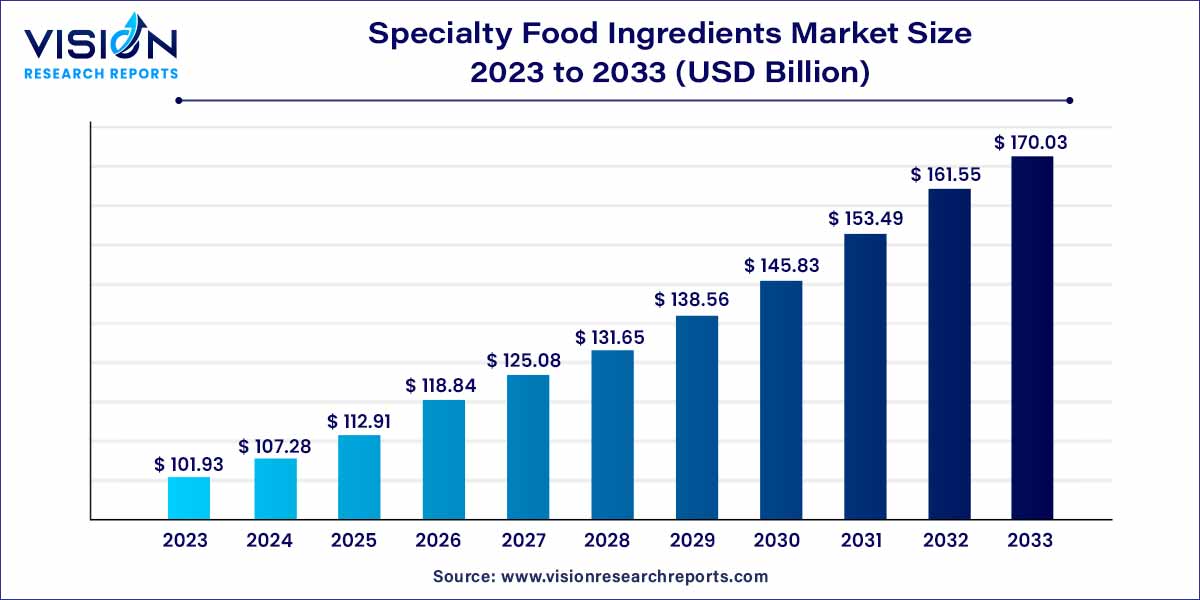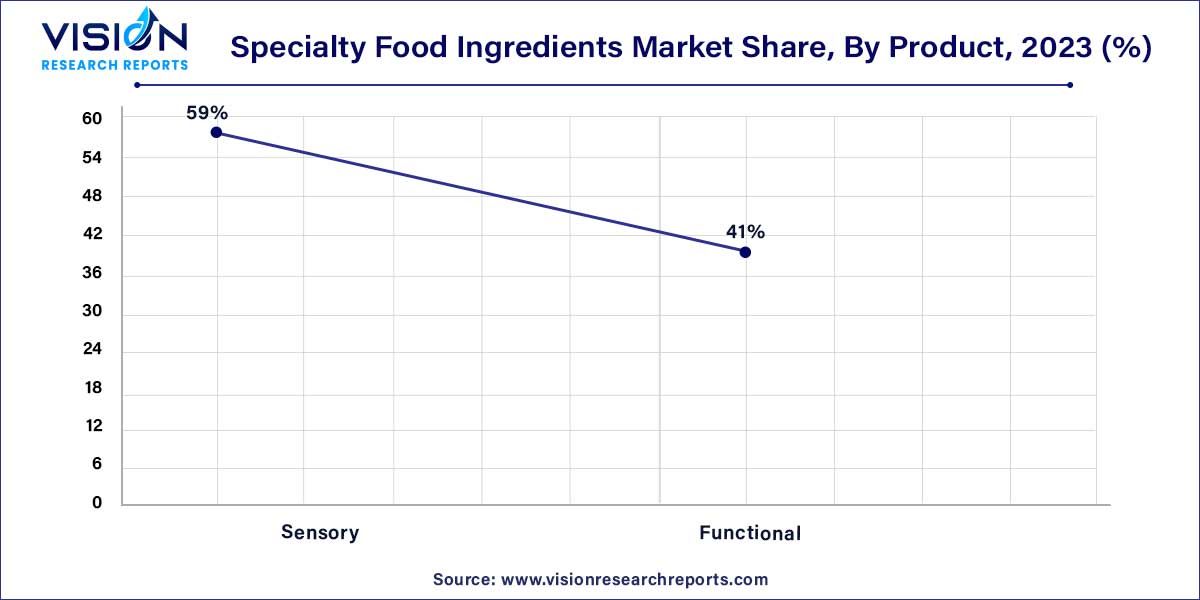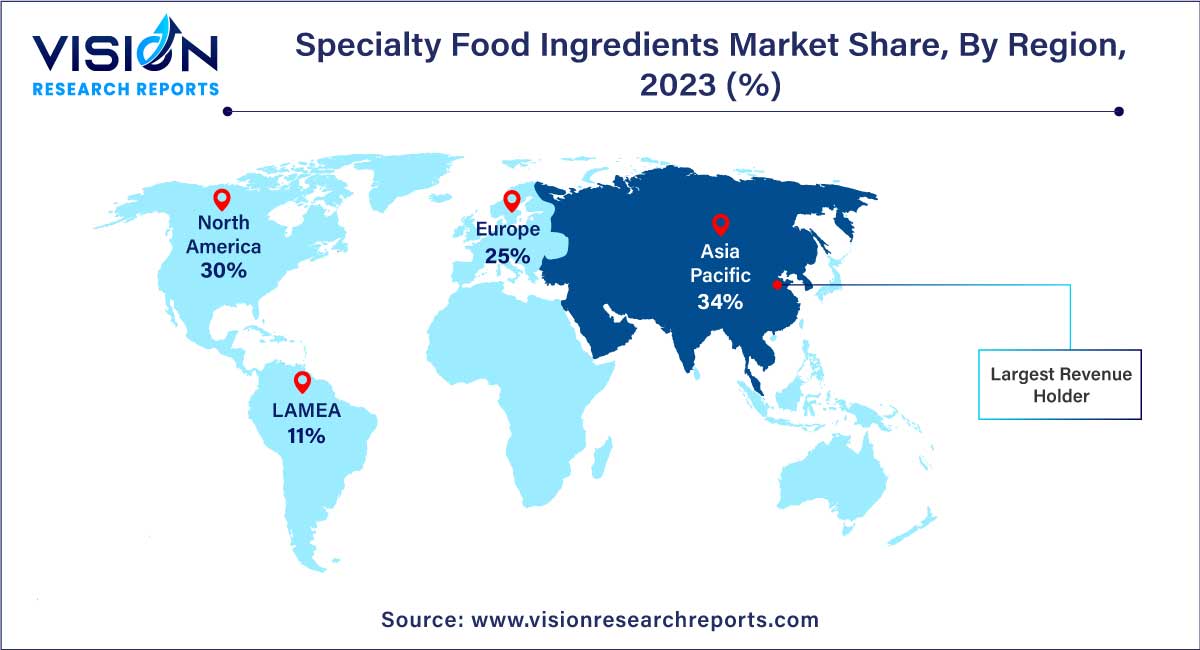The global specialty food ingredients market was estimated at USD 101.93 billion in 2023 and it is expected to surpass around USD 170.03 billion by 2033, poised to grow at a CAGR of 5.25% from 2024 to 2033.

The specialty food ingredients market is a dynamic sector characterized by a diverse array of products that play a pivotal role in shaping the modern food industry. These ingredients, known for their unique properties and contributions to flavor, texture, and nutritional value, have become integral components in the formulation of a wide range of food products.
The specialty food ingredients market is experiencing robust growth driven by several key factors. Changing consumer preferences play a pivotal role, with an increasing focus on health and wellness prompting a demand for high-quality ingredients that enhance both taste and nutritional value. The market is further propelled by innovations in food processing technologies, allowing manufacturers to create unique and differentiated products. The globalization of culinary trends has also contributed to the surge in demand, as consumers seek authentic and diverse flavors. Additionally, the clean label movement has influenced consumer choices, with a preference for natural and minimally processed ingredients. Despite challenges such as regulatory complexities and supply chain disruptions, these factors collectively contribute to the market's dynamic expansion, presenting opportunities for industry players to meet evolving consumer demands and maintain competitiveness.
| Report Coverage | Details |
| Market Revenue by 2033 | USD 170.03 billion |
| Growth Rate from 2024 to 2033 | CAGR of 5.25% |
| Revenue Share of Asia Pacific in 2023 | 34% |
| Base Year | 2023 |
| Forecast Period | 2024 to 2033 |
| Market Analysis (Terms Used) | Value (US$ Million/Billion) or (Volume/Units) |
The sensory segment held the largest revenue share of 59% in 2023. This dominance is attributed to the indispensable role sensory ingredients play in elevating the taste, aroma, flavor, and texture of food products. The heightened demand for such ingredients in packaged and convenience foods, as well as confectioneries, is anticipated to be a pivotal driver for the escalating demand for these sensory elements.
The flavor product market is notably influenced by the increasing preference for organic and natural ingredients. The ever-evolving tastes of consumers contribute to a surging demand for diverse flavor profiles. This trend is particularly evident in the flavor industry, strongly influenced by the consumption patterns in various foods and beverages. The rising popularity of ready-to-eat food products further fuels this growth, making a substantial impact on the food flavor market. The global demand for natural ingredients stands out as a primary catalyst propelling this market forward.

Vitamins find widespread application in meals, fortification in oils and fats, supplements, and infant formula. The choice of vitamins is contingent upon specific formulation requirements. Minerals, constituting essential components of a balanced diet, serve diverse functions and aid in the absorption of certain vitamins, such as calcium facilitating the absorbance of vitamin D by cells from the diet.
As a key ingredient, antioxidants play a crucial role in shielding finished products from issues like fat rancidity and color changes due to oxidation caused by bacteria, fungi, molds, and yeasts. The types of antioxidants employed depend on the formulation requirements of the specific diet. Preservatives, serving to maintain product quality over an extended period without compromise, are witnessing increased adoption due to changing consumer preferences for safe and hygienic packaged food, especially in developed regions. These distinctive product attributes enable manufacturers to meet the precise needs of processors, foreseeing a substantial boost in market growth over the next eight years.
The food and beverage segment contributed the largest market share of 71% in 2023. This dominance is primarily attributed to shifting consumer lifestyles and evolving food preferences, resulting in substantial growth within the processed food manufacturing sector. This, in turn, is expected to drive the demand for specialty food ingredients. Additionally, the escalating consumption of both alcoholic and non-alcoholic beverages, particularly among the younger demographic, is anticipated to further fuel growth within the industry.
The personal care industry has experienced significant growth, driven by heightened consumer awareness regarding the ingredients used in such products. Consumers are increasingly opting for natural and health-focused products, steering clear of harmful chemicals. Consequently, manufacturers are incorporating these special ingredients widely into their product offerings to meet the rising demand for natural and healthy personal care items.
Recognizing the value of specialty food ingredients, the pharmaceutical industry is increasingly integrating them into the development of new products aimed at improving patient health outcomes. These ingredients find application in various pharmaceutical realms, including drug delivery systems, nutraceuticals, and functional foods, showcasing their versatility and potential impact on health-related advancements.
The Asia Pacific region led the market with the largest market share of 34% in 2023. This commanding position is largely attributed to the surging popularity of convenience food, particularly in China, which has emerged as the largest market for emulsifiers in the region. The expansive population in China further contributes to the growth of the food and beverage, pharmaceutical, and personal care industries, establishing them as key drivers for the overall industry in the country.

Europe, in the same year, emerged as the second-largest regional market for specialty food ingredients. However, a relatively sluggish growth trajectory is anticipated over the forecast period. Renowned for its globally acclaimed cuisines, Europe experiences a continuous evolution in consumer preferences, leading to the frequent innovation of new recipes. Countries such as France, Italy, and Belgium stand out as major importers of specialty ingredients within the region. The presence of a significant number of processing and confectionery companies in Germany and the UK contributes to both production and demand for specialty food ingredients, reinforcing the region's position in the market.
By Product
By Application
By Region
Chapter 1. Introduction
1.1. Research Objective
1.2. Scope of the Study
1.3. Definition
Chapter 2. Research Methodology
2.1. Research Approach
2.2. Data Sources
2.3. Assumptions & Limitations
Chapter 3. Executive Summary
3.1. Market Snapshot
Chapter 4. Market Variables and Scope
4.1. Introduction
4.2. Market Classification and Scope
4.3. Industry Value Chain Analysis
4.3.1. Raw Material Procurement Analysis
4.3.2. Sales and Distribution Channel Analysis
4.3.3. Downstream Buyer Analysis
Chapter 5. COVID 19 Impact on Specialty Food Ingredients Market
5.1. COVID-19 Landscape: Specialty Food Ingredients Industry Impact
5.2. COVID 19 - Impact Assessment for the Industry
5.3. COVID 19 Impact: Global Major Government Policy
5.4. Market Trends and Opportunities in the COVID-19 Landscape
Chapter 6. Market Dynamics Analysis and Trends
6.1. Market Dynamics
6.1.1. Market Drivers
6.1.2. Market Restraints
6.1.3. Market Opportunities
6.2. Porter’s Five Forces Analysis
6.2.1. Bargaining power of suppliers
6.2.2. Bargaining power of buyers
6.2.3. Threat of substitute
6.2.4. Threat of new entrants
6.2.5. Degree of competition
Chapter 7. Competitive Landscape
7.1.1. Company Market Share/Positioning Analysis
7.1.2. Key Strategies Adopted by Players
7.1.3. Vendor Landscape
7.1.3.1. List of Suppliers
7.1.3.2. List of Buyers
Chapter 8. Global Specialty Food Ingredients Market, By Product
8.1. Specialty Food Ingredients Market, by Product, 2024-2033
8.1.1. Sensory
8.1.1.1. Market Revenue and Forecast (2021-2033)
8.1.2. Functional
8.1.2.1. Market Revenue and Forecast (2021-2033)
Chapter 9. Global Specialty Food Ingredients Market, By Application
9.1. Specialty Food Ingredients Market, by Application, 2024-2033
9.1.1. Food & Beverage
9.1.1.1. Market Revenue and Forecast (2021-2033)
9.1.2. Pharmaceutical
9.1.2.1. Market Revenue and Forecast (2021-2033)
9.1.3. Personal Care
9.1.3.1. Market Revenue and Forecast (2021-2033)
Chapter 10. Global Specialty Food Ingredients Market, Regional Estimates and Trend Forecast
10.1. North America
10.1.1. Market Revenue and Forecast, by Product (2021-2033)
10.1.2. Market Revenue and Forecast, by Application (2021-2033)
10.1.3. U.S.
10.1.3.1. Market Revenue and Forecast, by Product (2021-2033)
10.1.3.2. Market Revenue and Forecast, by Application (2021-2033)
10.1.4. Rest of North America
10.1.4.1. Market Revenue and Forecast, by Product (2021-2033)
10.1.4.2. Market Revenue and Forecast, by Application (2021-2033)
10.2. Europe
10.2.1. Market Revenue and Forecast, by Product (2021-2033)
10.2.2. Market Revenue and Forecast, by Application (2021-2033)
10.2.3. UK
10.2.3.1. Market Revenue and Forecast, by Product (2021-2033)
10.2.3.2. Market Revenue and Forecast, by Application (2021-2033)
10.2.4. Germany
10.2.4.1. Market Revenue and Forecast, by Product (2021-2033)
10.2.4.2. Market Revenue and Forecast, by Application (2021-2033)
10.2.5. France
10.2.5.1. Market Revenue and Forecast, by Product (2021-2033)
10.2.5.2. Market Revenue and Forecast, by Application (2021-2033)
10.2.6. Rest of Europe
10.2.6.1. Market Revenue and Forecast, by Product (2021-2033)
10.2.6.2. Market Revenue and Forecast, by Application (2021-2033)
10.3. APAC
10.3.1. Market Revenue and Forecast, by Product (2021-2033)
10.3.2. Market Revenue and Forecast, by Application (2021-2033)
10.3.3. India
10.3.3.1. Market Revenue and Forecast, by Product (2021-2033)
10.3.3.2. Market Revenue and Forecast, by Application (2021-2033)
10.3.4. China
10.3.4.1. Market Revenue and Forecast, by Product (2021-2033)
10.3.4.2. Market Revenue and Forecast, by Application (2021-2033)
10.3.5. Japan
10.3.5.1. Market Revenue and Forecast, by Product (2021-2033)
10.3.5.2. Market Revenue and Forecast, by Application (2021-2033)
10.3.6. Rest of APAC
10.3.6.1. Market Revenue and Forecast, by Product (2021-2033)
10.3.6.2. Market Revenue and Forecast, by Application (2021-2033)
10.4. MEA
10.4.1. Market Revenue and Forecast, by Product (2021-2033)
10.4.2. Market Revenue and Forecast, by Application (2021-2033)
10.4.3. GCC
10.4.3.1. Market Revenue and Forecast, by Product (2021-2033)
10.4.3.2. Market Revenue and Forecast, by Application (2021-2033)
10.4.4. North Africa
10.4.4.1. Market Revenue and Forecast, by Product (2021-2033)
10.4.4.2. Market Revenue and Forecast, by Application (2021-2033)
10.4.5. South Africa
10.4.5.1. Market Revenue and Forecast, by Product (2021-2033)
10.4.5.2. Market Revenue and Forecast, by Application (2021-2033)
10.4.6. Rest of MEA
10.4.6.1. Market Revenue and Forecast, by Product (2021-2033)
10.4.6.2. Market Revenue and Forecast, by Application (2021-2033)
10.5. Latin America
10.5.1. Market Revenue and Forecast, by Product (2021-2033)
10.5.2. Market Revenue and Forecast, by Application (2021-2033)
10.5.3. Brazil
10.5.3.1. Market Revenue and Forecast, by Product (2021-2033)
10.5.3.2. Market Revenue and Forecast, by Application (2021-2033)
10.5.4. Rest of LATAM
10.5.4.1. Market Revenue and Forecast, by Product (2021-2033)
10.5.4.2. Market Revenue and Forecast, by Application (2021-2033)
Chapter 11. Company Profiles
11.1. Naturex
11.1.1. Company Overview
11.1.2. Product Offerings
11.1.3. Financial Performance
11.1.4. Recent Initiatives
11.2. Givaudan
11.2.1. Company Overview
11.2.2. Product Offerings
11.2.3. Financial Performance
11.2.4. Recent Initiatives
11.3. Eli Fried Inc.
11.3.1. Company Overview
11.3.2. Product Offerings
11.3.3. Financial Performance
11.3.4. Recent Initiatives
11.4. KF Specialty Ingredients
11.4.1. Company Overview
11.4.2. Product Offerings
11.4.3. Financial Performance
11.4.4. LTE Scientific
11.5. Ingredion
11.5.1. Company Overview
11.5.2. Product Offerings
11.5.3. Financial Performance
11.5.4. Recent Initiatives
11.6. Associated British Foods Plc
11.6.1. Company Overview
11.6.2. Product Offerings
11.6.3. Financial Performance
11.6.4. Recent Initiatives
11.7. Kerry Group
11.7.1. Company Overview
11.7.2. Product Offerings
11.7.3. Financial Performance
11.7.4. Recent Initiatives
11.8. Agropur Cooperative
11.8.1. Company Overview
11.8.2. Product Offerings
11.8.3. Financial Performance
11.8.4. Recent Initiatives
11.9. Ashland Inc
11.9.1. Company Overview
11.9.2. Product Offerings
11.9.3. Financial Performance
11.9.4. Recent Initiatives
11.10. Archer Daniels Midland Company
11.10.1. Company Overview
11.10.2. Product Offerings
11.10.3. Financial Performance
11.10.4. Recent Initiatives
Chapter 12. Research Methodology
12.1. Primary Research
12.2. Secondary Research
12.3. Assumptions
Chapter 13. Appendix
13.1. About Us
13.2. Glossary of Terms
 Cross-segment Market Size and Analysis for
Mentioned Segments
Cross-segment Market Size and Analysis for
Mentioned Segments
 Additional Company Profiles (Upto 5 With No Cost)
Additional Company Profiles (Upto 5 With No Cost)
 Additional Countries (Apart From Mentioned Countries)
Additional Countries (Apart From Mentioned Countries)
 Country/Region-specific Report
Country/Region-specific Report
 Go To Market Strategy
Go To Market Strategy
 Region Specific Market Dynamics
Region Specific Market Dynamics Region Level Market Share
Region Level Market Share Import Export Analysis
Import Export Analysis Production Analysis
Production Analysis Others
Others